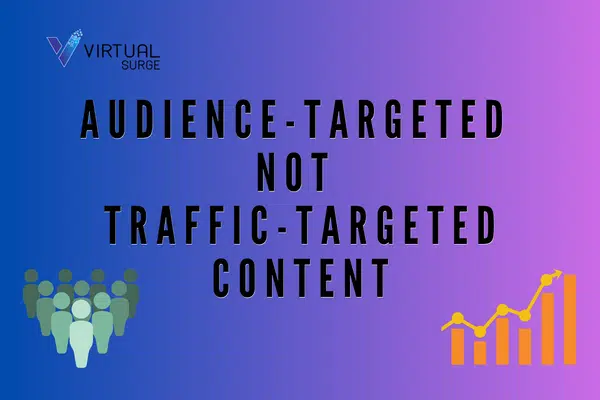In today’s dynamic digital landscape, where content reigns supreme, the success of your digital presence hinges upon a well-crafted content strategy. This strategy is the backbone of your online efforts, purposefully directing your content creation and distribution. Within this realm, the distinction between audience-targeted and traffic-targeted content is paramount, as it can be the key to unlocking meaningful engagement and long-term success.
Importance of Content Strategy
A robust content strategy is more than just a trend; it’s necessary. It lays the groundwork for your digital endeavors, providing a roadmap for what you create, when you share it, and where you share it. Without a clear strategy, your efforts could be akin to shooting arrows in the dark, hoping to hit something meaningful. By defining your content strategy, you align your efforts with your business goals, ensuring every piece of content serves a purpose.
Defining Audience-targeted and Traffic-targeted Content
Two distinct approaches emerge in the content landscape: audience-targeted and traffic-targeted content. Audience-targeted content focuses on catering to the needs, preferences, and pain points of a specific group of people – your target audience. Conversely, traffic-targeted content emphasizes attracting large visitors, often to boost numbers, but not necessarily building deep connections.
Understanding Audience-targeted Content

Identifying Your Target Audience
Central to the success of audience-targeted content is a clear understanding of your target audience. This entails delving into demographics, psychographics, and behaviors. Who are they? What motivates them? What challenges do they face? The answers to these questions guide your content direction.
Creating Buyer Personas for Precise Targeting
Buyer personas – detailed representations of your ideal customers – offer invaluable insights. Craft personas that go beyond superficial demographics and uncover your audience’s motivations, pain points, and aspirations. These personas enable you to craft content that speaks directly to their hearts and minds.
Tailoring Content to Address Audience Needs
Audience-targeted content is like a tailored suit – it fits perfectly. By addressing your audience’s unique needs and concerns, you position yourself as a reliable source of solutions. This fosters trust, which is a cornerstone of long-lasting customer relationships.
Downsides of Traffic-targeted Content

Focusing Solely on Numbers
While high traffic numbers might seem impressive, they hold little value if they don’t convert into meaningful engagement. Focusing solely on numbers can lead to a misguided strategy that fails to connect with your audience on a deeper level.
Bouncing Traffic and High Bounce Rates
Traffic-targeted content often attracts visitors who aren’t truly interested in what you offer. As a result, bounce rates – the percentage of visitors who leave your site after viewing only one page – can be alarmingly high. This indicates a lack of relevance and engagement.
Lack of Engagement and Conversion
Traffic without engagement is like a vehicle without fuel – it goes nowhere. Content not targeted toward your audience’s needs might attract visitors, but it fails to engage them or encourage conversion. This lack of engagement can ultimately harm your brand’s reputation.
Stay tuned for the next part of the article, where we delve into the benefits of audience-targeted content and how it can transform your digital strategy.
Benefits of Audience-targeted Content
Building Meaningful Connections
Audience-targeted content allows you to build connections that transcend fleeting interactions. You establish a genuine rapport when your content resonates with your audience’s needs and interests. This connection forms the basis of trust, loyalty, and advocacy.
Higher Engagement and Interaction
Content that speaks directly to your audience’s concerns ignites engagement. They are likelier to comment, share, and participate in discussions around topics that matter to them. This enhances your online community and extends your content’s reach.
Improved Conversion Rates and ROI
Engaged audiences are more likely to take desired actions, whether signing up for your newsletter, purchasing, or sharing their information. The result? Improved conversion rates and a healthier return on investment (ROI) for your content efforts.
Crafting Audience-targeted Content
In-depth Research and Analysis
To truly understand your audience, meticulous research is essential. Dive into their preferences, pain points, language, and digital behavior. Analyze existing data, conduct surveys, and explore social media interactions to gain a comprehensive understanding.
Addressing Specific Pain Points
Your audience seeks solutions to their problems. Addressing their pain points directly in your content positions you as a problem solver. Provide actionable insights and advice that alleviate their concerns, demonstrating your expertise.
Personalization and Relatability
The era of one-size-fits-all content is over. Personalization is the new standard. Tailor your content to speak directly to individual segments of your audience. Use relatable anecdotes, stories, and real-life examples to create a resonant connection.
Content Formats for Audience-targeted Approach
Educational Blog Posts
Deep-dive blog posts that provide valuable insights and practical guidance showcase your expertise and cater to your audience’s thirst for knowledge.
Problem-Solving Videos
Visual content that addresses common challenges and provides step-by-step solutions engages viewers and positions you as a trusted advisor.
Interactive Quizzes and Polls
Engage your audience with interactive content that entertains and provides valuable insights into their preferences and opinions.
Stay tuned for the subsequent sections, where we’ll explore leveraging data for content creation, implementing SEO for audience-targeted content, and measuring the success of your targeted strategy. Your journey toward effective content creation is just getting started.
Utilizing Data for Content Creation

Leveraging Analytics Insights
Your website analytics hold a treasure trove of information. Analyze which content resonates most with your audience, what drives engagement, and which channels bring the most valuable traffic. This data informs your content decisions.
Gathering Customer Feedback
Direct feedback from your audience provides invaluable insights. Conduct surveys, encourage comments, and actively listen to what your audience is saying. Their input can guide your content strategy and ensure it aligns with their needs.
Incorporating Trending Industry Data
Stay current by incorporating industry trends and data into your content. Sharing insightful industry reports, statistics, and expert opinions positions you as a thought leader and informs your audience.
Implementing SEO with Audience-targeted Content
Strategic Keyword Integration
Keyword research remains a cornerstone of SEO. Identify keywords that align with your audience’s search intent and incorporate them naturally into your content. This helps your content rank higher and reach the right eye.
Natural Language and Long-Tail Keywords
As search engines evolve, natural language and long-tail keywords are gaining importance. These keywords mimic how people speak and search, ensuring your content is discoverable by those seeking specific solutions.
High-Quality Backlinks from Relevant Sources
Build authority by acquiring high-quality backlinks from authoritative sources within your niche. These backlinks boost your SEO and enhance your credibility among your audience.
Measuring Success of Audience-targeted Strategy
Analyzing Engagement Metrics
Monitor metrics such as time on page, scroll depth, and click-through rates to gauge how engaged your audience is with your content. High engagement indicates content that resonates.
Tracking Conversion Rates
Conversion tracking reveals whether your audience is taking desired actions, such as signing up for newsletters or purchasing. This data reflects the effectiveness of your content in driving action.
Monitoring Social Media Shares and Comments
Social media is a barometer of content resonance. Track shares, comments, and interactions. More shares and meaningful discussions point to content that strikes a chord.
Avoiding Common Pitfalls
Overlooking Data Insights
Neglecting the data available to you leads to missed opportunities. Regularly review your analytics and adjust your strategy based on insights.
Neglecting Evolving Audience Preferences
Audience preferences are fluid. Stay attuned to shifts in your audience’s needs and adapt your content accordingly.
Being Too Niche or Too Broad
Balancing specificity with broader appeal is essential. Being too niche might limit your reach while being overly broad can dilute your content’s impact.
The journey towards audience-targeted content continues with a look into case studies showcasing brands that have excelled with this approach, followed by insights into future trends that will shape the content landscape. Let’s explore these next.
Case Studies: Brands Excelling with Audience-targeted Approach
Case Study 1: Company A’s Personalized Email Campaign
Company A leveraged audience insights to craft personalized email campaigns. They achieved higher open and click-through rates by tailoring content to individual preferences and needs, leading to improved conversions.
Case Study 2: Brand B’s Interactive Social Media Strategy
Brand B created interactive content that encouraged audience participation. Through quizzes, polls, and interactive posts, they fostered engagement and formed a community, resulting in a loyal following.
Stay tuned for the final section, where we’ll delve into the exciting future trends in audience-targeted content and conclude with a call to action that can transform your content strategy.
Future Trends in Audience-targeted Content
Embracing AI and Personalization Technology
Artificial intelligence will enable hyper-personalization, crafting content that adapts in real-time to individual preferences and behaviors.
Voice Search and Conversational Content
Creating content that aligns with conversational queries will be key to visibility as voice search gains traction.
Shifting SEO Focus toward User Intent
Search engines will increasingly prioritize content that fulfills user intent, rewarding content creators who truly address audience needs.
Conclusion
In the ever-evolving digital landscape, audience-targeted content is a beacon of relevance and engagement. By embracing the power of understanding your audience deeply, tailoring content to their needs, and strategically utilizing data and SEO, you pave the way for enduring success. As you embark on this content journey, remember that it’s not just about traffic; it’s about building connections, fostering engagement, and ultimately achieving long-term success through audience engagement.


